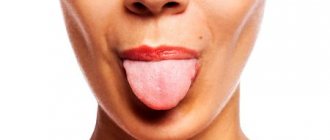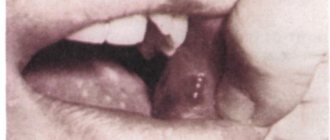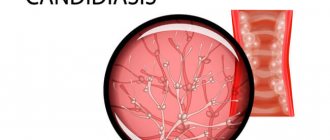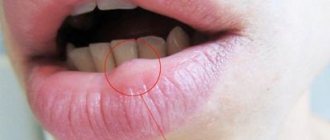Types Causes Treatment methods Diagnostics Prevention
Toothache does not always bring us to the dentist. Quite often, problems are caused not by teeth, but by unpleasant sensations in the mouth, red spots on the tongue, and a burning sensation. These signs are characteristic of a variety of diseases, often systemic, but can serve as symptoms of glossitis - inflammation of the tongue.
Causes of the problem
A red spot on the tongue can be a manifestation of a variety of pathologies, for example:
- Vitamin deficiency
Redness of the tongue is caused by a deficiency of B vitamins and niacin.
- Allergy
Response to food, drinks, drugs
- The burn is
not only thermal, but also chemical. The Internet is full of different, sometimes strange, advice. Experimenting on yourself can have sad consequences.
- Hormonal imbalance
Red spots on the tongue often appear in women during pregnancy and menopause.
- Infections of various etiologies
Bacteria and viruses provoke inflammatory processes, one of the symptoms of which is discoloration.
Red spots on the tongue are not yet a diagnosis. A doctor needs to conduct an examination to determine the exact cause.
Redness of the tongue may indicate various diseases.
Reds
The appearance of red spots on a child’s tongue is a sure sign of an infectious or inflammatory process in the oral cavity:
- stomatitis;
- glossitis;
- bacterial dermatosis;
- herpetic infection.
Also, red spots may be due to an allergic reaction or consumption of foods that are bright red in color.
Very often, such formations are accompanied by unpleasant symptoms: pain in the tongue, a feeling of discomfort, increased salivation. Due to pain, children may be capricious and refuse to eat or drink. The general condition may also suffer - body temperature rises.
Only a doctor should treat red spots. After establishing an accurate diagnosis, the following may be prescribed:
- treatment of lesions with antiseptic agents;
- taking antibiotics or antivirals;
- use of anti-inflammatory medications.
Diagnosis
It is difficult to independently distinguish relatively harmless manifestations of diseases in the form of red spots from serious disorders. Any rash on the tongue already indicates systemic problems, but some of them indicate serious cases.
Erythroplakia requires immediate surgical intervention. Therefore, it is better not to take the position “it will go away on its own,” but to consult a doctor.
Since spots on the tongue are a symptom of disease, examination is usually aimed at identifying the causes. Laboratory tests, flora tests, histology and medical history allow us to make the correct diagnosis and prescribe appropriate treatment.
Associated symptoms for accurate diagnosis
In some cases, a strange reddish spot appears on the tongue, but the person does not experience any associated symptoms. In such a situation, the doctor will need to carry out additional diagnostic procedures to identify the causes of the defect. However, most often “spotting” is accompanied by other characteristic symptoms:
- soreness,
- discomfort while eating,
- numbness of the organ,
- burning sensation,
- the appearance of purulent ulcers,
- bad breath,
- spots on other areas of the mucous membrane,
- the formation of a dense plaque directly on the organ.
Pain, burning, numbness of the tongue may be a symptom of the disease.
Other accompanying symptoms include a general deterioration in condition, loss of strength, increased temperature - all this may indicate the rapid spread of infection in the body. But nausea, bloating, heartburn, and digestive problems most often result from problems in the gastrointestinal tract.
Online consultation with a doctor if you are concerned about symptoms
If you are concerned about symptoms such as spots on the tongue, accompanied by burning, tingling, pain, then it is best to undergo an examination and consultation with a dentist. Because these may be signs of a more serious disease that should not be neglected, otherwise inaction will lead to the need for longer-term and more expensive treatment. Red spots on the surface of the tongue may indicate a fungal, viral, or venereal infection. It is often difficult to determine on your own what it is: glossitis, stomatitis, Kawasaki disease or something else. A specialist will help you understand the signs of the disease and etiology online. He will give professional recommendations, suggest treatment options and further actions.
Preventive measures
To prevent any disease of the tongue, it is important to take the most responsible approach to oral hygiene, monitor the cleanliness of the organ, brush your teeth at least twice a day with a brush and toothpaste, and rinse your mouth every time after a meal. In addition to these basic rules, you must adhere to other important recommendations from experts:
- try to eliminate too spicy, salty, sour and sweet foods from your diet, eat more vegetables and fruits,
- give up bad habits, such as smoking and uncontrolled drinking,
- periodically take multivitamin complexes to strengthen the immune system,
- spend more time in the fresh air, lead a physically active lifestyle,
- systematically visit the dentist for routine examinations.
When you find strange burgundy or light pink spots on the surface of your tongue, the main thing is not to panic. There are a great many reasons for this phenomenon, and to make an accurate diagnosis, you definitely cannot do without an examination by a specialist. If you notice any new growths on an organ, even if they do not hurt or cause discomfort, be sure to make an appointment with a doctor.
- Kargaltseva, N. M. The oral cavity is an important biotope of the human body, 2001.
Disease prevention
Dental measures include:
- Regular thorough oral care.
A properly selected toothbrush, constant flossing, and rinsing your mouth after eating will help avoid inflammatory processes.
- Use a toothpaste that suits the purpose at this stage. You cannot use whitening or medicinal pastes constantly, only in courses.
General preventive measures:
- Healthy lifestyle
- To give up smoking
- Regular medical examinations
Treatment of glossitis of the tongue
First of all, the treatment plan depends on the type of inflammation. It is compiled individually, based on clinical and diagnostic data. For acute catarrhal glossitis, it is important to remove the irritating factor: replace the crowns or, conversely, put crowns on the damaged tooth. Change your eating habits, stop chewing nuts, hard candies, and crackers.
For a folded tongue, oral hygiene comes to the fore.
If lumps and papillomas grow during rhomboid glossitis, they are excised. Laser surgery allows you to do this quickly, with virtually no blood.
The main recommendation for black tongue is treatment of somatic diseases and smoking cessation. Liquid nitrogen is used to remove papillae, as well as applications to keratinized areas.
But there is a general approach to treatment:
- sanitation of the oral cavity;
- professional teeth cleaning;
- vitamin complexes;
- iron supplements for anemia;
- for pain - light anesthetics in the form of applications;
- for burning - oral baths and irrigation;
- physiotherapeutic procedures;
- checking for fungal infections.
There are many recommendations on the Internet for treating glossitis with folk remedies. No one disputes the anti-inflammatory properties of chamomile, sage and plantain. When a spot appears on the tongue, applications of sea buckthorn oil and aloe juice can bring relief. But these measures are temporary, they affect the symptoms, but the cause of the disease remains unattended. As a result, it is easy to miss the point when it was not difficult to fix the problem.
Glossitis is closely related to common diseases and psychological causes. Effective treatment is only possible using an integrated approach. How to treat glossitis and what examinations you need to undergo can only be advised by a qualified doctor. Glossitis can be cured quite quickly, but if left untreated, abscesses, tumors, and necrotic tissue changes can form. This is much more serious and the prognosis is not so favorable.
Expert opinion
Roman Borisovich Alekperov
orthopedic dentist
Experience: 24 years
Most often, red spots on the tongue are not accompanied by pain. A slight burning sensation or no symptoms at all creates a dangerous feeling that the problem will go away on its own. This can worsen the condition and cause serious consequences. If you have red spots on your tongue, consult a doctor. It is better to quickly take measures recommended by professionals than to spend a long time on treatment later.
Types of glossitis
All inflammatory processes are divided into chronic and acute, independent and secondary, accompanying other diseases. In any case, problems with the tongue indicate the presence of a disease, so it is better to consult a doctor immediately. Sometimes glossitis occurs without pronounced manifestations, but the doctor will definitely notice changes in the tongue during a routine examination.
Independent diseases (when only the tongue is affected) include several types of inflammation.
Acute catarrhal glossitis
Most often it develops as a result of mechanical damage from sharp edges of decayed teeth, unsuccessful dentures, candies and nut shells. It is a sign of allergies, acute respiratory viral infections or gastrointestinal diseases.
Patients develop red spots on the base of the tongue. Patients experience pain while eating and talking. The tongue swells and becomes covered with a thick coating. Saliva production increases.
Desquamative glossitis
It has many names: geographic tongue, migrating, exfoliative glossitis. It is he who begins with red spots on the tongue. This occurs due to epithelial detachment (desquamation).
The reasons are not completely clear, but diseases play a certain role in the development of inflammation:
- stomach and intestines;
- edocrine glands;
- hematopoietic organs.
Infectious diseases can provoke inflammation
and
vitamin deficiency
.
All of them disrupt tissue nutrition and, as a result, the epithelium begins to slough off. The red spots are growing. As the spots increase in size, the process of keratinization begins in the center, and the keratinized areas, on the contrary, begin to flake off. This is how glossitis “migrates” from one part of the tongue to another. At the same time, its outline resembles a map, hence the name “geographical”.
In the vast majority, desquamative glossitis is discovered during routine examinations. For a long time it does not cause any inconvenience. But in advanced cases, the tongue begins to react to spices and sours. There are complaints of tingling and burning. The tongue becomes covered with cracks, which can become infected. In this case, the disease is accompanied by enlarged lymph nodes, general malaise, and weakness.
Diamond-shaped glossitis
This is an inflammation of the tongue in which red spots have clear boundaries
and
geometric shape
.
Among the reasons are:
- congenital nature of the disease;
- housing and communal services diseases;
- candidiasis of different nature and location.
There are 3 types
rhomboid inflammation. The flat look is the easiest, patients are unaware of it, and only a doctor can see the characteristic red spots on the root of the tongue.
The lumpy and papillomatous types are irritating with the sensation of a foreign body in the mouth. Sometimes patients complain of a burning sensation.
Black “hairy” tongue
With desquamative glossitis, the epithelium peels off too much. When the keratinized epithelial cells stop exfoliating at all, they speak of a “hairy tongue.” The size of the papillae increases. They change color as a result of the interaction of iron in food and oral microflora. Most often, the papillae become black or brown.
The reasons may be:
- gastritis;
- colitis;
- infections;
- tuberculosis;
- venereal diseases;
- smoking;
- alcoholic drinks in excessive quantities.
The disease develops gradually and for a long time patients do not pay attention to the changes. Therefore, the sight of a “hairy” tongue can cause a lot of stress. Patients complain of burning, itching, dryness, and foreign body sensation. Sometimes, when talking, gagging occurs. Taste sensations often change.
Folded tongue
This congenital anomaly is detected in children and adults. It is diagnosed less often in children due to the fact that the folds are small. During the period of intensive growth, in puberty, with the growth of muscle tissue, the tongue also increases, the folds appear more clearly. Characterized by changes in the shape and size of the tongue. The transverse folds are smaller, the longitudinal folds are well defined. The main problem of pathology is the accumulation of food debris and bacterial waste products in the folds. This is a favorable environment for microorganisms. They penetrate small cracks and provoke the development of other forms of glossitis. In particular, in 50% of cases, a folded tongue is combined with migrating glossitis. Often inflammation is caused by fungal infections, such as candidiasis.
There is no specific treatment. In the presence of a fungal infection, drugs with a fungicidal effect and ointments against the fungus are prescribed. It is recommended to carefully observe oral hygiene and, along with brushing your teeth, clean your tongue with special scrapers.
Glossodynia
Glossodynia
is a burning mouth syndrome. It usually starts with the appearance of red spots on the tip of the tongue. The tongue is sore and tingling. Pain appears, which subsides while eating, but intensifies in the evening. In 80% of patients, saliva production decreases. The tongue swells, desquamation (detachment of the epithelium) begins. The tongue becomes covered with cracks.
Where to contact
Any dentist will be able to help with advice, but it is still better to contact multidisciplinary clinics. The larger the clinic, the more patients, which means the doctors’ experience is much wider. In addition, high-quality specialists are rarely seen in modest dentistry on the outskirts of the city; they mostly work in large centers. Another reason to contact a multidisciplinary center is that they pay great attention to improving the qualifications of doctors, including in therapeutic dentistry.
The table shows contacts of 5 clinics where you will be advised about red spots on the tongue.
| Dental center | Clinic address | Working hours |
| ROOT | Moscow, st. Rustaveli, 14 building 9 8 800 775–26–37 | 10:00-22:00 seven days a week |
| Your smile.rf | Moscow, Palikha street, 10, building 9 8 | 9:00-21:00 seven days a week |
| Center Family Dentistry | Moscow, Orekhovy Boulevard, 59k2 8 | 9:00-21:00 seven days a week |
| Unident | Moscow, Bobrov lane, 4, building 1 8 | 9:00-21:00 seven days a week |
| CityDent | Moscow, st. Novocheremushkinskaya, 57 8 | 10:00-23:00 day off - Sunday |
How is therapy carried out?
Treatment of the symptom in question first requires identifying the source of the problem, that is, the primary cause. If the change in the condition of the tongue is the result of an injury or allergy, then the patient needs to reconsider his diet, eliminate the allergen and be more attentive to the condition of the oral cavity, try not to injure the mucous membrane with foreign objects.
If the culprit is a certain disruption in the functioning of the internal systems, then you cannot do without the help of a highly specialized doctor - a general practitioner or dentist, depending on who you contacted, will redirect you to a gastroenterologist, endocrinologist or immunologist.
An ultrasound will help determine the cause of the pain.
But for symptomatic treatment, it is advised to resort to traditional medicine. Many medicinal herbs have long been famous for their antiseptic, soothing and wound-healing properties. Just remember: the use of all kinds of infusions and decoctions for mouth rinsing is allowed only with the consent of the attending physician. Additionally, experts prescribe antifungal drugs, vitamin complexes and immunomodulators. If the tongue is very painful, painkillers must be prescribed.
Small model of the whole organism
In a healthy person, it is soft, pink, perhaps with a slight white coating, the longitudinal groove is even.
If this is not the case, you should pay attention to where exactly the redness and other changes appeared. They will help identify the diseased internal organ
:
- tip - heart;
- the first third after the tip is the lungs;
- center - spleen;
- the part between the center and the root is the buds;
- root - intestines;
- lateral parts - liver, gall bladder.
Photo: unnaturally red tongue with spots
What to look for when examining the oral cavity:
- On spots of various colors,
- raid,
- ulcers,
- wounds;
- neoplasms,
- itching,
- dashes.
The brighter and more saturated the color of the plaque, the more serious the problem may be.
What are the reasons for the development of geographic language in a child? Read about it in our article.
Find out the answer to the question - which is the best oral irrigator to choose and what is its approximate price.
Here: https://www.vash-dentist.ru/lechenie/yazyik-l/prichinyi-vozniknoveniya-chernogo-naleta.html - they will tell you about the causes and treatment of black plaque on the tongue.
Homeopathic remedies
| Drugs | Purpose |
| Acidum nitricum | Rashes on the mucous membrane, areas of bleeding, pain and impaired salivation. |
| Mercurius solubilis | For swelling of the tongue, unpleasant odor and impaired salivation. |
| Sulfur | For the treatment of inflammatory processes, impaired taste, symptoms of unquenchable thirst and thick gray plaque on the mucous membrane. |
| Schussler Salze | For the treatment of various types of stomatitis, including desquamative or deep glossitis. |
| Potassium sulfate | With accompanying erosions, ulcers, fungal infections. |
| Borax | Aimed at accelerating regenerative processes when there is damage to the mucosa. |
| Kalium bichromicum | For ulcers and redness on the sides of the tongue and in the root area, it helps to calm. |
| Arsenicum | For the treatment of aphthae, which are accompanied by pain and severe inflammation of the tongue. |
| Acidum nitricum | To eliminate tongue ulcers in young children and adults. |
What does this mean?
The appearance of red dots on the tongue can be caused by a number of reasons, including those that do not threaten health and life. However, in some cases, such rashes indicate the appearance of a specific disease.
Red dots can have different origins:
- wound, petechiae - slight hemorrhage (with a burn of the tongue, for example);
- telangiectasia, that is, spider veins;
- ulcer;
- erosion;
- epithelial tumor of malignant and benign nature;
- rashes (macula, papule, roseola).
That is why it is of great importance to seek medical help in the case when a person finds red dots on the root of the tongue, as well as on other parts of this organ, in his child or himself.
Pale tongue tone
Also, red dots on the tip of the tongue without plaque occur with anemia, but the organ itself turns pale, which is very easy to confuse with deposits. When detecting spots on the tongue, a person does not need to immediately worry and panic. First, you should observe your own condition and check whether such spots disappear within a few days. If there are no changes, even after adjusting the diet and the absence of bad habits, it is advisable to still go to see a doctor and take all the tests required to diagnose the disease, as well as undergo an examination.
Red dots on the tongue and white coating
In some cases, the appearance of red dots is also accompanied by a yellowish or white coating, which is expressed to a certain extent. When it appears on the root of the tongue, the doctor will most likely discover intestinal or stomach pathologies in the patient. These may include, for example, chronic gastritis. In this case, the therapist will most likely refer the patient to a gastroenterologist.
A tongue covered with a white coating and red dots is often accompanied by bad breath. In this case, the cause could be her illness (for example, stomatitis) or diseases of the intestines and stomach. In some cases, the source of pathological signs is insufficient oral hygiene, so you need to brush your teeth on time and use rinses after meals.










